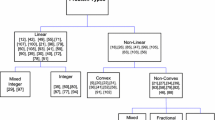Abstract
Our proposed research aims to empower the wireless applications with the renewable energy sources and the emerging communication technologies to promote the green economy in a more efficient, reliable, and sustainable manner. It seeks to address the system performance, planning, and resource allocation problems by exploiting cooperation among available network re-sources with renewable energy sources for green wireless communication infrastructure deployment. Besides energy efficiency, it is important to investigate the spectral efficiency aspect of the green radio techniques. Moreover, owing to the broadcast nature of the medium and the associated security vulnerabilities, it is important to augment secrecy even at physical layer of communications.


Similar content being viewed by others
References
CISCO, Cisco visual networking index: global mobile data traffic forecast update, 2014–2019, White Paper, Feb 2015
Han C et al (2011) Green radio: radio techniques to enable energy efficient networks. IEEE Commun Mag 49(6):46–54
Paradiso JA, Starner T (2005) Energy scavenging for mobile and wireless electronics. IEEE Pervasive Comput 4(1):18–27
Sudevalayam S, Kulkarni P (2011) Energy harvesting sensor nodes: survey and implications. IEEE Commun Surv Tutor 13(3):443–461 Third Quart
Kim TK, Kim HM, Song MG, Im GH (2015) Improved spectrum-sharing protocol for cognitive radio networks with multiuser cooperation. IEEE Trans Commun 63(4):1121–1135
Wyner AD (1975) The wire-tap channel. Bell Syst Technol J 54(8):1355–1387
Chen X, Ni W, Wang X, Sun Y (2016) Optimal quality-of-service scheduling for energy-harvesting powered wireless communications. IEEE Trans Wirel Commun 15(5):3269–3280
Raghunathan V, Ganeriwal S, Srivastava M (2006) Emerging techniques for long lived wireless sensor networks. IEEE Commun Mag 44(4):108–114
Varshney LR (2008) Transporting information and energy simultaneously. In: Proceedings of IEEE ISIT, Toronto, Canada
Zhou X, Zhang R, Ho CK (2013) Wireless information and power transfer: architecture design and rate-energy tradeoff. IEEE Trans Commun 61(11):4754–4767
Nasir AA, Zhou X, Durrani S, Kennedy RA (2015) Wireless-powered relays in cooperative communications: time-switching relaying protocols and throughput analysis. IEEE Trans Commun 63(5):1607–1622
Hoang DT, Niyato D, Wang P, Kim DI (2014) Opportunistic channel access and RF energy harvesting in cognitive radio networks. IEEE J Sel Areas Commun 21(11):2039–2052
Liu Y, Mousavifar SA, Deng Y, Leung C, Elkashlan M (2016) Wireless energy harvesting in a cognitive relay network. IEEE Trans Wirel Commun 15(4):2498–2508
Zheng G, Ho Z, Jorswieck EA, Ottersten B (2014) Information and energy cooperation in cognitive radio networks. IEEE Trans Sig Process 62(9):2290–2303
Nguyen BV, Jung H, Har D, Kim K (2018) Performance analysis of a cognitive radio network with an energy harvesting secondary transmitter under Nakagami-m fading. IEEE Access 6:4135–4144
Evans B et al (2005) Integration of satellite and terrestrial systems in future multimedia communications. IEEE Trans Wirel Commun 12(5):72–80
Bhatnagar MR, Arti MK (2013) Performance analysis of AF based hybrid satellite-terrestrial cooperative network over generalized fading channels. IEEE Commun Lett 17(10):1912–1915
An K, Lin M, Ouyang J, Huang Y, Zheng G (2014) Symbol error analysis of hybrid satellite-terrestrial cooperative networks with cochannel interference. IEEE Commun Lett 18(11):1947–1950
Dong Lun, Han Zhu, Petropulu Athina P, Vincent Poor H (2010) Improving wireless physical layer security via cooperating relays. IEEE Trans Signal Process 58(3):1875–1888
Zhang R, Song L, Han Z, Jiao B (2012) Physical layer security for two-way untrusted relaying with friendly jammers. IEEE Trans Veh Technol 61(8):3693–3704
Lei J, Han Z, Castro MAV, Hjorungnes A (2011) Secure satellite communication systems design with individual secrecy rate constraints. IEEE Trans Inf Forens Secur 6(3):661–671
Acknowledgements
This R&D project work is undertaken through Young Faculty Research Fellowship of the Visvesvaraya Ph.D. Scheme of Ministry of Electronics & Information Technology (MeitY), Government of India, being implemented by Digital India Corporation (formerly Media Lab Asia). India has deeply investing in making our cities smart and clean. In fact, the current government dispensation has raised the stakes substantially in the march towards green and clean environments. Integral to smart city deployments would be dispersion of wireless devices of all kinds. The proposed project and the fellowship build upon this expectation of the government and a successful implementation of the ideas being floated have the potential to very significantly contribute to the mission. Moreover, the fellowship has facilitated research collaborations with far reaching consequences. As such, the fellowship would also help to validate peers work and ensure that the end result is robust and sustainable. The value addition through the collaborative research is therefore expected to be immense.
Author information
Authors and Affiliations
Corresponding author
Rights and permissions
About this article
Cite this article
Upadhyay, P.K. Development of spectral- and energy-efficient wireless communication techniques. CSIT 8, 165–169 (2020). https://doi.org/10.1007/s40012-020-00286-4
Received:
Accepted:
Published:
Issue Date:
DOI: https://doi.org/10.1007/s40012-020-00286-4




